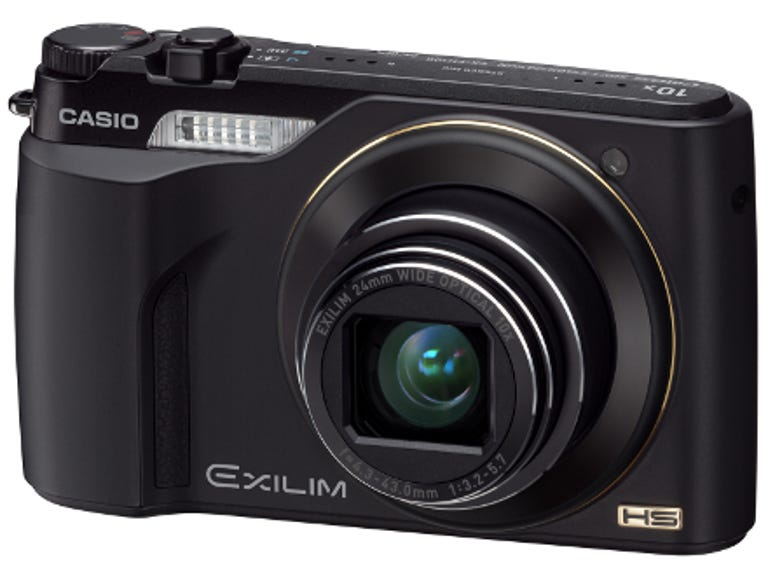 Why You Can Trust CNET
Why You Can Trust CNET Casio Exilim EX-FH100 review: Casio Exilim EX-FH100
The 10.1-megapixel Exilim EX-FH100 is a compact superzoom with a twist. As well as a 10x zoom range, it can shoot photos at up to 40 frames per second and movies at up to 1,000fps. That makes it a good choice if you're in the habit of shooting action scenes
Compact superzooms are very versatile and popular cameras. Casio offers a couple, including the 10.1-megapixel Exilim EX-FH100 with 10x zoom, which is up against some great rivals, such as the Panasonic Lumix DMC-TZ10. But the FH100 is a superzoom with a twist, offering high-speed shooting at up to 40 frames per second and movies at speeds of up to 1,000fps. When you consider what this camera can do, £250 suddenly doesn't seem that much to pay.
The Good
The Bad
The Bottom Line
High-speed hijinks
Those incredible speeds are achieved using Casio's 'continuous shutter' technology and high-speed processing. You'd expect some pay-off in terms of reduced resolution and limited recording capacity, but it's nowhere near as severe as you might think. Shooting stills, the resolution drops to 9 megapixels and the buffer's capacity is 30 images, but that's still enough to capture dramatic, high-resolution images of extremely fast-moving action.

At 30 frames per second, the FH100 shoots standard 720p high-definition footage. Providing you can accept a progressive drop in resolution, it can also shoot at speeds of anywhere from 30 to 120fps (at 640x480 pixels), right up to 1000fps (at a tiny 224x64-pixel resolution).
Timing your recordings with these high-speed burst rates can be tricky, but the FH100 has a pre-record function that helps. It uses the camera's buffer to continually record the action so that, when you press the shutter, it can add what's already been recorded to the final sequence.
The high-speed shooting tech is also used in some of the 'best shot' scene modes, like the 'high-speed lighting' mode, which combines a series of images at different exposures to produce a single high-dynamic-range photo. It works pretty well, too. There are low-light and anti-blur modes that combine a series of shots to produce a single sharp image, and there's even a mode that captures a portrait sequence and automatically picks out the frames in which the subject is smiling or not blinking.
Other clever functions include 'move in' and 'move out' modes that trigger the camera when the subject moves in or out of the focus area. Again, that's very useful for timing high-speed action shots.
Quite apart from all these high-speed shooting features, the FH100 looks like a pretty decent camera in its own right. Its build quality and finish are very good indeed, it zooms in and out quickly (despite its wide focal range), and its autofocus is snappy too. It even has aperture-priority, shutter-priority and manual exposure modes, and can shoot raw files in the universal DNG format, so there's no need for a bespoke software application.
Ooh, baby, I like it raw
Alas, it takes the FH100 around 10 seconds to save each raw file, and, while the results are worth it (you get better colours, for example), that delay makes raw shooting useless as an everyday option. Also, comparing the raw images with the camera's JPEGs suggests that the FH100 uses internal distortion correction, making the lens look slightly better than it actually is. It's not a bad lens as compact superzooms go, but it suffers from a degree of chromatic aberration at the edges of the picture, and softens up significantly at full zoom. The lens is okay, but it's by no means the best.
It's also a shame that Casio couldn't have devoted some of its obvious technological expertise towards providing a movie mode with use of the autofocus and zoom. Instead, you have to pick a zoom setting and press the shutter button halfway down to focus before you start. You might expect that in a budget camera, but not one with a gazillion different hi-tech movie options.
Conclusion
Casio's continuous shutter technology is unique. Other camera manufacturers -- Sony, for example -- are catching up, but Casio did it first and it's utilised this tech in a host of innovative and useful ways. The Exilim EX-FH100 still has flaws, however, and one of the biggest is the fact that you can't use the autofocus or zoom when shooting movies.
Edited by Charles Kloet
